Thursday, August 31, 2006
Our final days...
Our time in Alaska is coming to a close. It's amazing how fast a year goes! We are not sure when we will be back to stay (or if) but we definitely have some plans in the works for visits (Ski Train 2007?). Our final trip on the Goat Trail in Wrangell-St. Elias National Park starts on Saturday. After a fly-in start, we will be packpacking for four days to our pick-up point, 20 miles away. Should be fun! The pick-up is at around 6000' so we expect to get into a little snow as well! Our internet connection between now and when we arrive in Seattle will be sparse so I don't know how much posting we will do but hopefully I can put up a few pics after getting back to Anchorage and before hitting the road to Seattle.
Monday, August 28, 2006
Lost Lake Breath of Life Race
Saturday was our final mountain race of the season, the Lost Lake race outside Seward. The whole course is 16 miles, starting with 5 miles of steady climbing up to Lost Lake, then a few miles of undulating trail around morraines and lake shores, finishing with 6 miles of glorious downhill that, if you have the legs, you can hit at break-neck speeds.
We didn't really have a goal for this race except to have fun and beat the time required to qualify for next year's Crow Pass Crossing (we are already pre-qualified because we ran the race this year so it was more of a do-it-for-fun kind of thing). Chester, Andrea, and I met this goal with change to spare and had a great time along the way.
Respective times:
Chester - 2:08:22
Aaron - 2:10:59
Andrea - 2:27:38
We didn't really have a goal for this race except to have fun and beat the time required to qualify for next year's Crow Pass Crossing (we are already pre-qualified because we ran the race this year so it was more of a do-it-for-fun kind of thing). Chester, Andrea, and I met this goal with change to spare and had a great time along the way.
Respective times:
Chester - 2:08:22
Aaron - 2:10:59
Andrea - 2:27:38
Friday, August 25, 2006
Thursday, August 24, 2006
Storm hiking
Not the be confused with storm skiing (which is fun), storm hiking sort of blows, especially when the storm in question is dumping sideways rain on you that 15m higher up the mountains is snow. But that's what it was on Tuesday when Andrea and I took our friends Jen and Tasha, and Tasha's sister Kat (all visiting from Montana) up to Rabbit Lake.

We didn't even make it to the lake before turning around, everyone freezing and Jen on the border of hypothermia. But the Montana girls are tough and there was nary a peep about the weather out of any of them. In fact, I think Kat looked kind of disappointed that we were turning around. Here are three shots in the thirty seconds I exposed the camera to the elements.
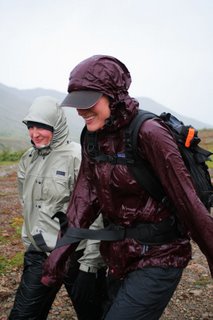


We didn't even make it to the lake before turning around, everyone freezing and Jen on the border of hypothermia. But the Montana girls are tough and there was nary a peep about the weather out of any of them. In fact, I think Kat looked kind of disappointed that we were turning around. Here are three shots in the thirty seconds I exposed the camera to the elements.


I'm going to get in trouble for this...

Finally, the ski industry has shed it's prudery and gotten back to it's dorm-room hijinx, sophmoric roots. Exhibit 1 - this Stockli ad from this month's Powder Buyer's Guide - although the model appears somewhat, uh, German, the intention was there.
It harkens back to another time, when Lange ski boots ran a series of ads featuring "Lange girls" in various ski related poses and text with unquestionable inuendo.
Examples are here (yes, that's Pamela Anderson wearing the boot I had in highschool).
Ok, so this type of stuff is immature, sexist, and objectifies women. There is no question about that. And Stockli's ad does not have half the humor that the Lange posters did back in the day. (I guess the only people less funny than Germans are Swiss.) But at least we are taking ourselves less seriously. Right? It appears, at least in some form, that the Lange girls, with their dorm-room bathroom humor, are back.
For those not already totally repulsed by this post, here is a picture from Powder 1976, the year I was born (read the barn's roof). Awesome.
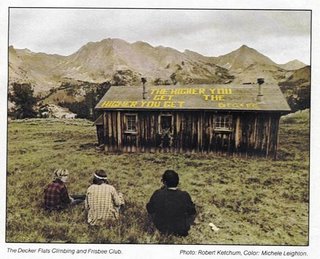
Monday, August 21, 2006
A break in the clouds...
After 12 or so days of solid rain, leading to flooding in the Mat-Su valley, the clouds this morning broke and the sun shone down. It's supposed to start raining again tonight but the clearing sky has revealed the mountains around Hatcher Pass and outside Eagle River are covered with snow, much more than a dusting, indicating winter is around the corner!
Friday, August 18, 2006
Coming into the Country
 Perhaps it is because our time in Alaska is coming to a close but I have been immersing myself in Alaskana for the last few months, hoping maybe to glean some extra meaning from the wonderful year we have spent here. As a native Alaskan, I am not sure reading a few books from Alaska will help put more meaning into a life than that which was infused through a childhood in Bear Valley but who knows. Law school can do funny things to a person.
Perhaps it is because our time in Alaska is coming to a close but I have been immersing myself in Alaskana for the last few months, hoping maybe to glean some extra meaning from the wonderful year we have spent here. As a native Alaskan, I am not sure reading a few books from Alaska will help put more meaning into a life than that which was infused through a childhood in Bear Valley but who knows. Law school can do funny things to a person.I just finished what I think is one of the true books of Alaska, John McPhee’s Coming into the Country. The non-fiction work breaks apart into three subsections, each dealing with an aspect of Alaska that many people who visit for only a short time don’t see. Nor should they necessarily; it is clear through the book’s 400 plus pages that McPhee, a man from New Jersey, has not only done his homework but gone to great lengths to find the "true Alaska."
The first section, entitled The Encircled River, follows a group of five men (McPhee including himself) as they travel down the Salmon River in the Brooks Range in norther Alaska, whose watershed is "wholly above the Arctic Circle." The men are surveying the Salmon River for possible inclusion in the list of national wild rivers, which would set aside the river and its immediate environs as unalterable wild terrain. At the time of the writing, 1977, Congress was still considering the legislation.
The descriptions of travel down the Salmon merge into a stream of conscious meditation on wildland conservation, the shortage of good fishing in Anchorage, and the native people who live in northwestern Alaska. This section presents the reader with a lay of the land, both physical and emotional, and defines the boundaries of the political, ethical, and moral dilemmas that challenged Alaskans in those pre-pipeline years and that still linger today.
The second section, What They Were Hunting For, is a wonderful snapshot of the original movement in Alaska to move the capital from Juneau to a location closer to Anchorage. Juneau is ringed on all sides by mountains and ocean, providing access for state legislators and the public they represent only via oceangoing ferry or a harrowing and often unreliable plane ride. This isolation was seen as a burden to the represented, a boon to their representitives.
McPhee accompanies the Capital Site Selection Committee as it tours by helicopter potential sites north of Anchorage, most notably near Talkeetna and Juneau. Among the committee members are such famous Alaskans and Arliss Sturgulewski and Willie Hensley. McPhee seems to have an uncanny ability to place himself at the center of the action.
McPhee provides a lengthy history of the naming of Juneau and how the town was founded, suggesting that while its birth and existence may be credited to drunken prospectors’ blind luck, this history is as Alaskan as any and justifies naming the town capital.
Better still, McPhee provides some very telling descriptions of Anchorage (my home town) in its 70s heyday. As evidenced here:
Anchorage is sometimes excused in the name of pioneering. Build now, civilize later. But Anchorage is not a frontier town. It is virtually unrelated to its environment. It has come in on the wind, an American spore. A large cookie cutter brought down on El Paso could lift something like Anchorage into the air. Anchorage is the northern rim of Trenton, the center of Oxnard, the ocean-blind precincts of Dayton Beach. It is condensed, instant Albuquerque.
McPee appreciates the boom nature of Anchorage, the drive of its citizens to consume. But McPhee is quick to point out this development is not in a vacuum and gives us context in descriptions of the ring of mountains and ocean "stunning against the morning and in the evening light" that surround and cradle the town.
But all of this is building material, foundation for the final and longest chapter whose name also graces the cover of the book itself, Coming Into the Country. The phrase is Alaska backcountry slang for moving into the bush. McPhee spends the bulk of this chapter himself coming into the country, living all four seasons in Eagle, Alaska, nestled in east-central Alaska along the Yukon River. Here, if any feelings of distrust have developed in the reader’s mind from McPhee’s disparaging remarks about Anchorage or his awkwardness with wilderness travel, all is forgiven. McPhee’s portrait of the people who inhabit Eagle as a place and a time is magical. McPhee describes in the words of one Eagle resident the importance of Alaska as a location on the landscape of the American mind:
In the society as a whole, there is an elemental need for a frontier outlet, for a pioneer place to go – important even to those who do not go there. People are entioning outer space as, in this respect, all we have left. All we have left is Alaska, which, on the individual level, and by virtue of its climate, will always screen its own, and will not be overrun.
McPhee is fair with the local populace - allowing himself to be taken in by a miner's plea upon destroying the ecosystem around a creekbed that the mine is just a "cork in the sea." After rationalizing the destruction in his own head, despite the meager gains of a salt shaker's worth of gold, McPhee declares: "In the ecomilitia, bust me to private."
MePhee also reconciles his fear of bears that manifested itself in the first chapter. Upon his first taste of ursa horibilis McPhee waxes: "In strange communion, I had chewed the flag, consumed the symbol of the total wild, and, from that meal forward, if a bear should ever wish to reciprocate, it would only be what I deserve." In the hands of a less adroit craftsman, this sentiment would risk audience alienation by revealing the author's own still-unrecognized naivetee but McPhee is forgiven and admitted into the fold of his new more wild self.
On such topics as the Alaska state flag, McPhee is equally generous and gives hints at the change Alaska has wrought within his own self.
The flag, as it happens, was designed by a native. It is lyrically simple, the most beautiful of all American flags. On its dark-blue field, gold stars form the constellation of the Great Bear. Above that is the North Star. Nothing else, as the designer explained, is needed to represent Alaska. It was the flag of the Territory for more than thirty years. Alaskans requested that it become the flag of the new state. The designer was a thirteen-year-old Aleut boy.
While McPhee’s painting of the Alaskan soul leaves patches untended, and while the pre-pipeline boom attitude is beginning to feel threadbare at the edges, there is something in McPhee’s account that touches bedrock. His myriad anecdotes, woven together with thoughtfully placed historical facts and enlightened yet spare commentary are more than the sum of their parts. There is a feeling upon leaving this book that McPhee somehow got it, got why we are here, and more importantly, what our hopes and visions may lead us to.
Monday, August 07, 2006
Crow Pass Cabin
 Just after arriving back in Anchorage from fishing in Seward, Andrea and I took her family up to Crow Pass, outside of Girdwood, for a night's stay in a Forest Service cabin.
Just after arriving back in Anchorage from fishing in Seward, Andrea and I took her family up to Crow Pass, outside of Girdwood, for a night's stay in a Forest Service cabin.The hike in is "only" 3.5 miles, but almost all of it is uphill, with the grade becoming progressively steeper as you reach the top of the pass. The cabin is seated at the top of the pass next to Crystal Lake, a deep green alpine lake formed by the terminal moraine of a retreating glacier.
The family made it up to the cabin with no problem, in much faster time than I had anticipated. Coming from the flatlands of Wisconsin, I was pretty impressed how well they climbed up hills. After a brief rest and unloading at the cabin, we headed to the very top of the pass and were afforded great views of the Raven Glacier just on the other side.
We had a nice "backcountry" dinner of risotto and salmon that we had caught in Seward accompanied by 4 bottles of red wine we carried up with us (yes, actual glass bottles). We stayed up until after dark playing Mexican Train, an addicting game Andrea's brother Dan taught us using 12-sided dominos (yes, he carried an entire tin of dominos to the cabin too).
The weather was a perfect mix of sun and dramatic clouds with just a hint of rain on our decent back to the car. We arrived at the car around 11 and had a nice breakfast of sourdough pancakes at the Bakeshop in Girdwood.
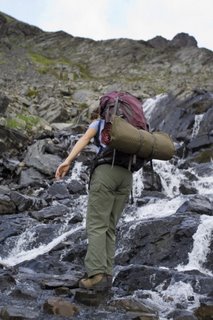
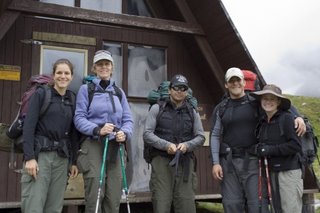

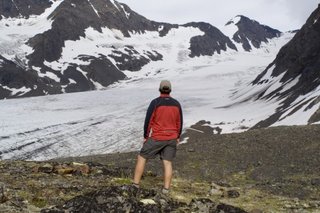
Wednesday, August 02, 2006
Silvers in Seward
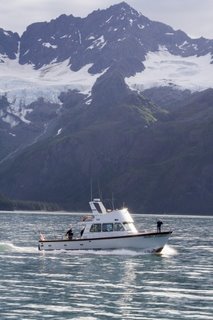 This weekend, Andrea and I headed to south to Seward with her parents, Joe and Vickie, and her brother Dan and his fiancee Megan. We chartered a boat to drive around Kenai Fjords National Park, take in some sight seeing and fish for silver salmon.
This weekend, Andrea and I headed to south to Seward with her parents, Joe and Vickie, and her brother Dan and his fiancee Megan. We chartered a boat to drive around Kenai Fjords National Park, take in some sight seeing and fish for silver salmon.The wildlife viewing was very successful; we saw puffins, sea otters, sea lions and got very close to a small local pod of orcas.
Kenai Fjords National Park is one of the most beautiful places in Alaska in my humble opinion. The fjords were carved out thousands of years ago by massive glaciers, which left deep gouges in the landscapes. As the glaciers retreated into the valleys, sea water filled them up to steep cliff sides. Now, forests of huge coniferns grow down from the glaciers right up to the edges of the cliffs, whose steep faces provide habitat for countless species of birds and marine mammals. There are still numerous places where the glaciers still flow directly into the ocean and the crashes and booms as they calve into the ocean can be heard for miles.
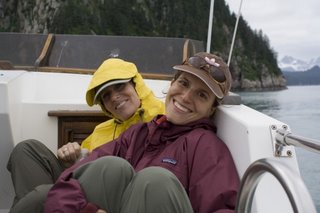
The weather cooperated as much as could be hoped in Seward; the sun was in and out for most of the day with some banks of fog rolling in from the Gulf of Alaska making things very eerie at times. A large bank of rain clouds rolled in off the Chugach Mountains as we motored back to Seward at the end of the day, making for some spectacular weather viewing (we were safely inside the cabin of the boat at this point).
Unfortunately, we had a few mishaps. The skipper of the boat didn't realize that none of us had fishing licenses until we were about an hour out of Seward (it was never really clear whose responsibility this was). So our exit from Resurrection Bay was slightly delayed while we drove back to get licensed.
In addition to forgetting our licenses, the engine in our boat seemed to be running a little rich all day. Near the end of the trip, the skipper discovered the fuel injector was leaking, which forced us to get a rescue at the end of the day by another of the company's boats. But waiting for the other boat gave us added time to fish and, although we probably only fished for an hour total, we pulled in 8 silvers (our legal limit was 18).

Our freezer is now full of silvers!







